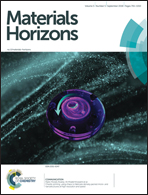Aqueous photo(electro)catalysis with eumelanin thin films†
Abstract
We report that eumelanin, the ubiquitous natural pigment found in most living organisms, is a photocatalytic material. Though the photoconductivity of eumelanin and its photochemical reactions with oxygen have been known for some time, eumelanins have not been regarded as photofaradaic materials. We find that eumelanin shows photocathodic behavior for both the oxygen reduction reaction and the hydrogen evolution reaction. Eumelanin films irradiated in aqueous solutions at pH 2 or 7 with simulated solar light photochemically reduce oxygen to hydrogen peroxide with accompanying oxidation of sacrificial oxalate, formate, or phenol. Autooxidation of the eumelanin competes with the oxidation of donors. Deposition of thin films on electrodes yields photoelectrodes with higher photocatalytic stability compared with the case of pure photocatalysis, implicating the successful extraction of positive charges from the eumelanin layer. These results open up new potential applications for eumelanin as a photocatalytically-active biomaterial, and inform the growing fundamental body of knowledge about the physical chemistry of eumelanins.

- This article is part of the themed collection: Horizons Community Board Collection – Emerging 2D Materials for Energy and Electronics Applications


 Please wait while we load your content...
Please wait while we load your content...